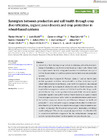Synergism between production and soil health through crop diversification, organic amendments and crop protection in wheat-based systems
dc.contributor.author
Walder, Florian
dc.contributor.author
Büchi, Lucie
dc.contributor.author
Wagg, Cameron
dc.contributor.author
Colombi, Tino
dc.contributor.author
Banerjee, Samiran
dc.contributor.author
Hirte, Juliane
dc.contributor.author
Mayer, Jochen
dc.contributor.author
Six, Johan
dc.contributor.author
Keller, Thomas
dc.contributor.author
Charles, Raphaël
dc.contributor.author
van der Heijden, Marcel G.A.
dc.date.accessioned
2023-10-24T07:36:24Z
dc.date.available
2023-08-29T05:49:01Z
dc.date.available
2023-08-31T12:28:02Z
dc.date.available
2023-10-24T07:36:24Z
dc.date.issued
2023-10
dc.identifier.issn
0021-8901
dc.identifier.issn
1365-2664
dc.identifier.other
10.1111/1365-2664.14484
en_US
dc.identifier.uri
http://hdl.handle.net/20.500.11850/628631
dc.identifier.doi
10.3929/ethz-b-000628631
dc.description.abstract
1. One of the critical challenges in agriculture is enhancing yield without compromising its foundation, a healthy environment and, particularly, soils. Hence, there is an urgent need to identify management practices that simultaneously support soil health and production and help achieve environmentally sound production systems.
2. To investigate how management influences production and soil health under realistic agronomic conditions, we conducted an on-farm study involving 60 wheat fields managed conventionally, under no-till or organically. We assessed 68 variables defining management, production and soil health properties. We examined how management systems and individual practices describing crop diversification, fertiliser inputs, agrochemical use and soil disturbance influenced production—quantity and quality—and soil health focusing on aspects ranging from soil organic matter over soil structure to microbial abundance and diversity.
3. Our on-farm comparison showed marked differences between soil health and production in the current system: organic management resulted in the best overall soil health (+47%) but the most significant yield gap (−34%) compared to conventional management. No-till systems were generally intermediate, exhibiting a smaller yield gap (−17%) and only a marginally improved level of soil health (+5%) compared to conventional management. Yet, the overlap between management systems in production and soil health properties was considerably large.
4. Our results further highlight the importance of soil health for productivity by revealing positive associations between crop yield and soil health properties, particularly under conventional management, whereas factors such as weed pressure were more dominant in organic systems.
5. None of the three systems showed advantages in supporting production-soil health-based multifunctionality. In contrast, a cross-system analysis suggests that multifunctional agroecosystems could be achieved through a combination of crop diversification and organic amendments with effective crop protection.
6. Synthesis and applications: Our on-farm study implies that current trade-offs in managing production and soil health could be overcome through more balanced systems incorporating conventional and alternative approaches. Such multifunctionality supporting systems could unlock synergies between vital ecosystem services and help achieve productive yet environmentally sound agriculture supported by healthy soils.
en_US
dc.format
application/pdf
en_US
dc.language.iso
en
en_US
dc.publisher
Wiley-Blackwell
en_US
dc.rights.uri
http://creativecommons.org/licenses/by-nc-nd/4.0/
dc.subject
balanced agricultural systems
en_US
dc.subject
conservation agriculture
en_US
dc.subject
ecosystem multifunctionality
en_US
dc.subject
organic farming
en_US
dc.subject
productivity
en_US
dc.subject
soil improving cropping systems
en_US
dc.subject
soil quality
en_US
dc.subject
trade-offs
en_US
dc.title
Synergism between production and soil health through crop diversification, organic amendments and crop protection in wheat-based systems
en_US
dc.type
Journal Article
dc.rights.license
Creative Commons Attribution-NonCommercial-NoDerivatives 4.0 International
dc.date.published
2023-08-16
ethz.journal.title
Journal of Applied Ecology
ethz.journal.volume
60
en_US
ethz.journal.issue
10
en_US
ethz.journal.abbreviated
J. Appl. Ecol.
ethz.pages.start
2091
en_US
ethz.pages.end
2104
en_US
ethz.version.deposit
publishedVersion
en_US
ethz.identifier.wos
ethz.identifier.scopus
ethz.publication.place
Oxford
en_US
ethz.publication.status
published
en_US
ethz.leitzahl
ETH Zürich::00002 - ETH Zürich::00012 - Lehre und Forschung::00007 - Departemente::02350 - Dep. Umweltsystemwissenschaften / Dep. of Environmental Systems Science::02703 - Institut für Agrarwissenschaften / Institute of Agricultural Sciences::03982 - Six, Johan / Six, Johan
ethz.leitzahl.certified
ETH Zürich::00002 - ETH Zürich::00012 - Lehre und Forschung::00007 - Departemente::02350 - Dep. Umweltsystemwissenschaften / Dep. of Environmental Systems Science::02703 - Institut für Agrarwissenschaften / Institute of Agricultural Sciences::03982 - Six, Johan / Six, Johan
ethz.date.deposited
2023-08-29T05:49:04Z
ethz.source
WOS
ethz.eth
yes
en_US
ethz.availability
Open access
en_US
ethz.rosetta.installDate
2024-02-03T05:40:09Z
ethz.rosetta.lastUpdated
2024-02-03T05:40:09Z
ethz.rosetta.versionExported
true
ethz.COinS
ctx_ver=Z39.88-2004&rft_val_fmt=info:ofi/fmt:kev:mtx:journal&rft.atitle=Synergism%20between%20production%20and%20soil%20health%20through%20crop%20diversification,%20organic%20amendments%20and%20crop%20protection%20in%20wheat-based%20systems&rft.jtitle=Journal%20of%20Applied%20Ecology&rft.date=2023-10&rft.volume=60&rft.issue=10&rft.spage=2091&rft.epage=2104&rft.issn=0021-8901&1365-2664&rft.au=Walder,%20Florian&B%C3%BCchi,%20Lucie&Wagg,%20Cameron&Colombi,%20Tino&Banerjee,%20Samiran&rft.genre=article&rft_id=info:doi/10.1111/1365-2664.14484&
Files in this item
Publication type
-
Journal Article [128962]

